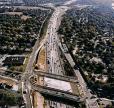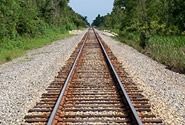the golden age | subsidized competition | interurbans | transforming transportation for the future
Railroad's Impact on American Society
The Golden Age of Railroading
1916 is the year generally given as the date when railroads reached their apex in the United States. Ninety-eight percent of all intercity passenger and 77% of all intercity freight traffic was shipped by rail. Almost every family in America had a father, brother, uncle, or cousin working for the railroad. Almost no American lived beyond the sound of a locomotive's whistle.
In song, story, and influence, railroads were as deeply embedded in American culture as television is today. Fathers took their families to the local depot on Sunday afternoons to watch the world go by and catch up on the latest news.
People were dependent on the railroads for almost every product produced and consumed in this country, or imported from overseas: milk for your table, coal to heat your home, the new stove or icebox, even the shiny new automobile in your driveway...
The Railroad touches the pond about a hundred rods
[550 yards] south of where I dwell. I usually
go to the village along its causeway, and am,
as it were, related to society by this link. The
whistle of the locomotive penetrates my woods
summer and winter, sounding like the scream of
a hawk sailing over some farmer's yard...
- Henry Thoreau
(The famous poet contemplating upon the railroad's value to man and the admirable sense of American enterprise and industry that it represented)
Railroad's Demise - Subsidized Competition
 Railroad ridership declined considerably during the 1960s. A major reason for this was the creation of the Interstate highway system by President Dwight D. Eisenhower in 1957. This was originally planned as a military system, allowing troops and tanks to be moved swiftly around the country in case of attack. At the height of the Cold War, this made sense.
Railroad ridership declined considerably during the 1960s. A major reason for this was the creation of the Interstate highway system by President Dwight D. Eisenhower in 1957. This was originally planned as a military system, allowing troops and tanks to be moved swiftly around the country in case of attack. At the height of the Cold War, this made sense.
In retrospect, policies like this forced railroads to, in essence, compete with the government; the railroads owned and paid taxes on their tracks, equipment, and physical plant, while the government subsidized highway and airport construction and operation. In 1961, for example, taxes paid by the railroads operating Washington, D.C.'s Union Station exactly equaled the operating deficit picked up by the government for Washington's National Airport. This was a form of competition the railroads could not win.
By the late 1960s, the future was clear even to the ICC. Nowhere in the world did passenger train service make money, but Europe and Japan had excellent systems run by the governments involved. Passenger trains there were seen as a necessary service to be provided for their people, similar to the air traffic control system or highway snow removal in this country.
Interurbans
 Mention should be made as well of the extensive system of electric streetcars and interurbans that once
provided service for thousands of cities and towns. Electric trolleys and streetcars
began appearing in the early 1880s. Easy to construct and maintain,
clean and convenient, they were perfect for moving large numbers of people around or through congested urban areas. Interurbans
were similar cars that connected adjacent cities or metropolitan areas. At one time it was possible to travel by interurban
from Plymouth, Wisconsin to upstate New York without ever riding on the regular railroad system.
Mention should be made as well of the extensive system of electric streetcars and interurbans that once
provided service for thousands of cities and towns. Electric trolleys and streetcars
began appearing in the early 1880s. Easy to construct and maintain,
clean and convenient, they were perfect for moving large numbers of people around or through congested urban areas. Interurbans
were similar cars that connected adjacent cities or metropolitan areas. At one time it was possible to travel by interurban
from Plymouth, Wisconsin to upstate New York without ever riding on the regular railroad system.
Beginning in the 1930s, bus, rubber tire, and oil interests, led by General Motors, began purchasing streetcar and interurban lines. The tracks were taken up and the trolleys replaced with buses. In April 1949, a federal court found these interests guilty of having criminally conspired to replace electric transportation with buses and monopolizing the sale of buses to local transportation companies. Clearly, the country's love affair with the automobile was in full swing.
Ironically, many cities are today looking at "light rail," the modern successor of the streetcar, as an alternative to the gridlock and pollution of the automobile, and several have begun constructing costly new systems. One wonders what might have been, if the original systems remained intact.
Transforming Transportation - The Future of U.S. Railroads?
 America's railroads—if given proper attention and resources, offer an economically and ecologically valid alternative to our current over-dependence on the automobile.
America's railroads—if given proper attention and resources, offer an economically and ecologically valid alternative to our current over-dependence on the automobile.
Read about how our nation's trains can help in resolving America’s energy and transportation challenges. Transforming Transportation ![]()
